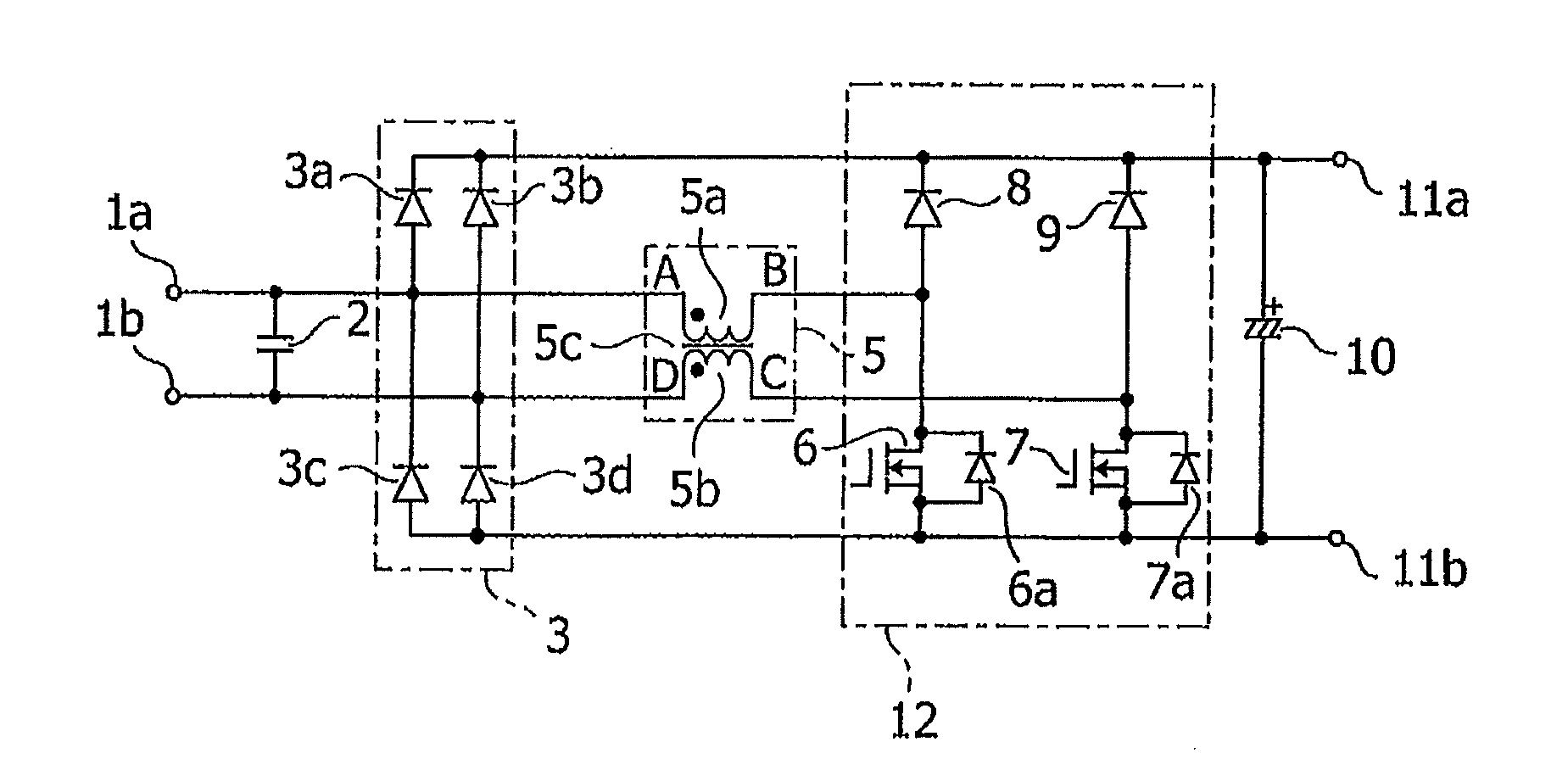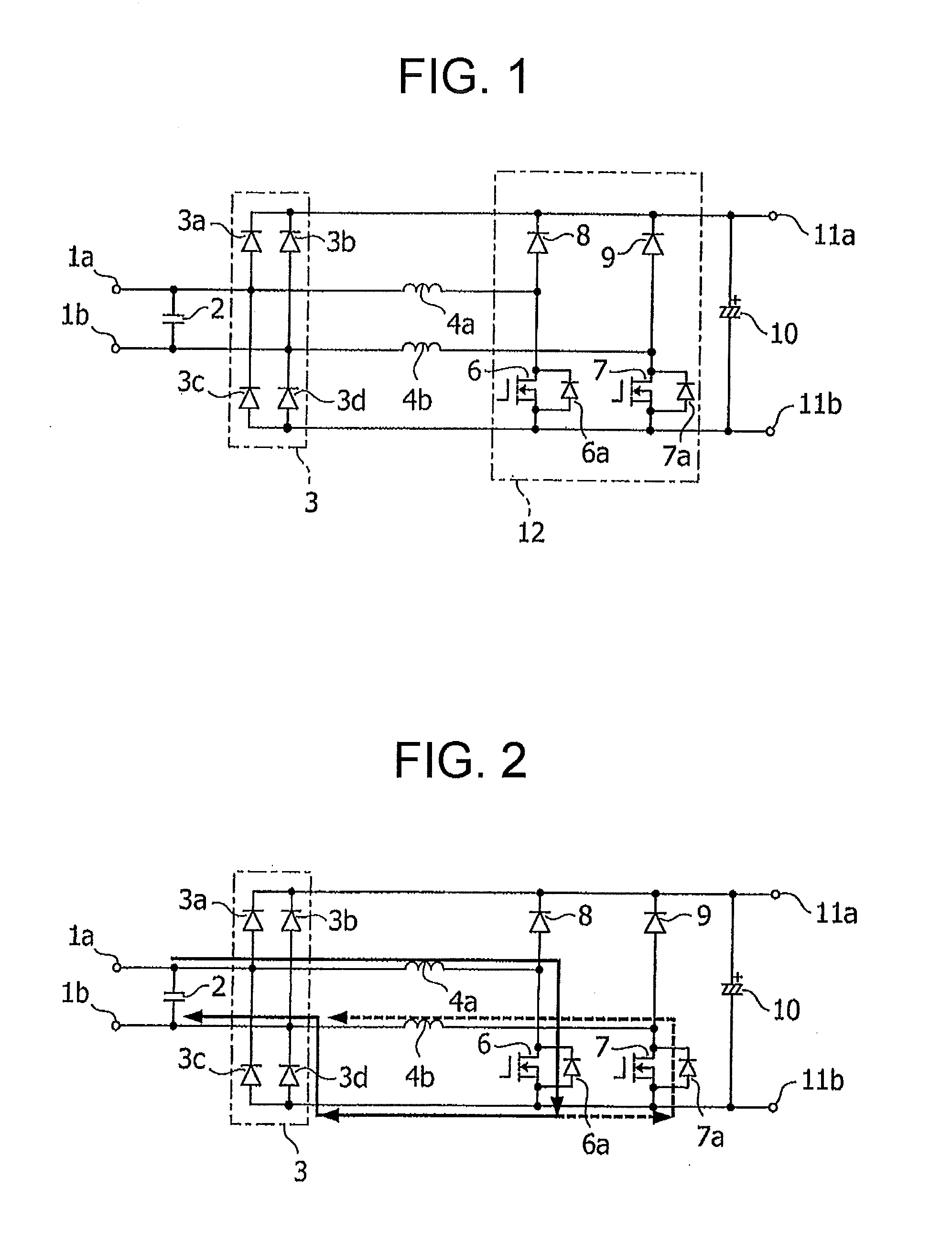Power factor correction circuit
a power factor and circuit technology, applied in the emergency protective circuit arrangement, emergency protection circuit arrangement, energy industry, etc., can solve the problems of complex circuit configuration, and inability to achieve overcurrent bypass, etc., to achieve the effect of reducing the changing rate of current flowing through the inductor, reducing the power loss caused in the diode in the second rectifying bridge circuit, and reducing the power loss caused in the switching device and the rectifying devi
- Summary
- Abstract
- Description
- Claims
- Application Information
AI Technical Summary
Benefits of technology
Problems solved by technology
Method used
Image
Examples
first embodiment
[0062]FIG. 1 is a circuit diagram showing a power factor correction circuit according to the invention. In FIG. 1, the same reference numerals as used in FIG. 18 are used to designate the same constituent elements and their duplicated description are omitted for the sake of simplicity.
[0063]The power factor correction circuit according to the first embodiment is different from the conventional power factor correction circuit shown in FIG. 18 in that rectifying bridge circuit 3 is interposed between AC input terminals 1a and 1b and rectifying bridge circuit 12. The power factor correction circuit shown in FIG. 1 is different from the conventional power factor correction circuit shown in FIG. 18 also in that inductor 4a is interposed between AC input terminal 1a and the first input of rectifying bridge circuit 12, and inductor 4b is interposed between AC input terminal 1b and the second input of rectifying bridge circuit 12. In contrast, in the conventional power factor correction cir...
second embodiment
[0072]FIG. 5 is a circuit diagram showing a power factor correction circuit according to the invention.
[0073]The power factor correction circuit according to the second embodiment is different from the power factor correction circuit according to the first embodiment in that inductors 4a and 4b are replaced by inductor 5 in FIG. 5.
[0074]FIG. 6 is a drawing showing the detailed structure of inductor 5 shown in FIG. 5.
[0075]As shown in FIG. 6, inductor 5 includes windings 5a and 5b wound around core 5c to be coupled magnetically to each other. Windings 5a and 5b are wound such that the direction of the magnetic flux ψ1 generated by the current I1 that flows from terminal A to terminal B is opposite to the direction of the magnetic flux ψ2 generated by the current I2 that flows from terminal C to terminal D.
[0076]Next, the operations of the power factor correction circuit according to the second embodiment will be described below.
[0077]First, steady-state operations will be described. ...
third embodiment
[0098]The power factor correction circuit facilitates reducing the electric power transmitted through one group of the circuit as compared with the circuit shown in FIG. 5. Therefore, the losses caused by inductors 5, 5′, MOSFETs 6, 6′, 7, 7′, and diodes 8, 8′, 9, 9′ are dispersed, and, as a result, the downsizing of the heat sink for cooling the semiconductor devices (MOSFETs 6, 6′, 7, 7′, etc.) and the downsizing of inductors 5 and 5′ are facilitated.
[0099]The circuit, a plurality of which is connected in parallel, is not always limited to the circuit shown in FIG. 5. The circuit, a plurality of which is to be connected in parallel, may be the circuit shown in FIG. 1 with no problem. The number of groups connected in parallel is not always limited to 2. Three or more groups of the circuit may be connected in parallel with no problem. In the power factor correction circuit shown in FIG. 13, rectifying bridge circuit 3 and smoothing capacitor 10 are used commonly for the circuit gr...
PUM
 Login to View More
Login to View More Abstract
Description
Claims
Application Information
 Login to View More
Login to View More - R&D
- Intellectual Property
- Life Sciences
- Materials
- Tech Scout
- Unparalleled Data Quality
- Higher Quality Content
- 60% Fewer Hallucinations
Browse by: Latest US Patents, China's latest patents, Technical Efficacy Thesaurus, Application Domain, Technology Topic, Popular Technical Reports.
© 2025 PatSnap. All rights reserved.Legal|Privacy policy|Modern Slavery Act Transparency Statement|Sitemap|About US| Contact US: help@patsnap.com



